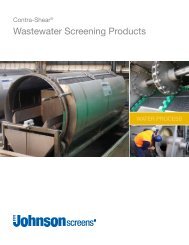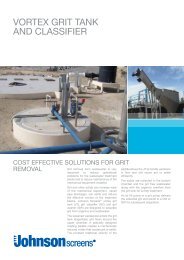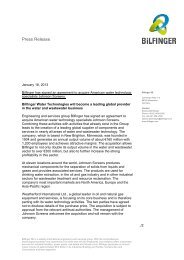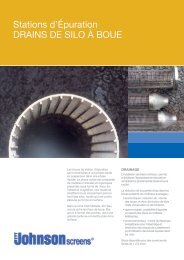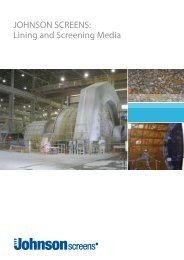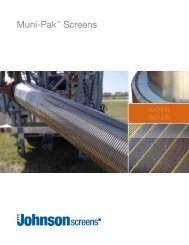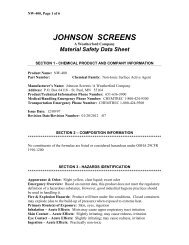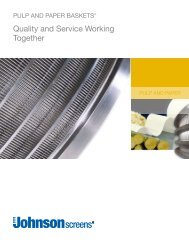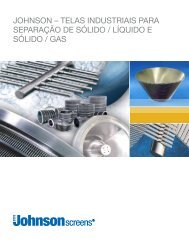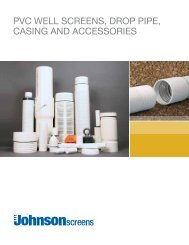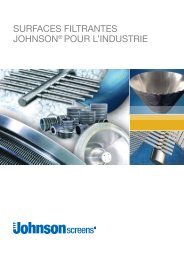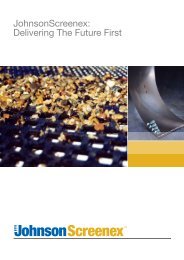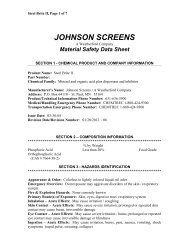NW-100 MSDS Sheet.pdf - Johnson Screens
NW-100 MSDS Sheet.pdf - Johnson Screens
NW-100 MSDS Sheet.pdf - Johnson Screens
You also want an ePaper? Increase the reach of your titles
YUMPU automatically turns print PDFs into web optimized ePapers that Google loves.
JOHNSON SCREENS®<br />
A Weatherford Company<br />
Material Safety Data <strong>Sheet</strong><br />
1. CHEMICAL PRODUCT AND COMPANY INFORMATION<br />
Product Name: <strong>NW</strong>-<strong>100</strong><br />
Chemical Family: Powdered Sulfamic acid in pellet form<br />
Application: Well Rehabilitation<br />
Manufacturer/Supplier:<br />
<strong>Johnson</strong> <strong>Screens</strong> /A Weatherford Company<br />
P.O. Box 64118 – St. Paul, MN 55164<br />
Telephone Number: 651-636-3900<br />
Contact: Al Smith - Extension 160 (Technical Service)<br />
Emergency Phone Number: CHEMTREC 1-800-424-9300<br />
Issue Date: 01-01-96<br />
Revision Date/Revision Number: 01-26-11<br />
Prepared by:<br />
<strong>Johnson</strong> <strong>Screens</strong>/A Weatherford Company<br />
Telephone: 1-800-833-9473<br />
2. COMPOSITION INFORMATION/INFORMATION ON INGREDIENTS<br />
************************************************************************<br />
Substance Weight Percent (%) CAS # OSHA PEL ACGIH TWA<br />
Sulfamic Acid +70% 5329-14-6 not established<br />
No constituents of the formulae are listed or considered hazardous under OSHA 29CFR<br />
1910.1200<br />
3. HAZARDS IDENTIFICATION<br />
************************************************************************<br />
Appearance & Odor: Yellow-brown pellet<br />
Emergency Overview: Strong powdered acid – be aware of air movement<br />
Fire & Explosion Hazards: None<br />
Primary Route(s) of Exposure: Skin, eyes, and inhalation<br />
Inhalation – Acute Effects: Irritation of nose and throat, may cause damage to lungs in<br />
extreme cases<br />
Page 1 of 6<br />
Material Safety Data <strong>Sheet</strong> <strong>NW</strong> <strong>100</strong>
Skin Contact – Acute Effects: Skin irritation usually develops over time<br />
Eye Contact – Acute Effects: May be severe if not immediately washed from the eyes<br />
Ingestion – Acute Effects: Sour, bitter taste, severe irritation to mouth and esophageal<br />
area<br />
4. FIRST AID MEASURES<br />
************************************************************************<br />
Inhalation First Aid: Remove affected person from area to fresh air and provide oxygen<br />
if breathing is difficult. Give artificial respiration ONLY if breathing has stopped and<br />
give CPR ONLY if there is no breathing and no pulse. Obtain medical attention.<br />
Skin Contact First Aid: Immediately remove clothing from affected area and wash skin<br />
for 15 minutes with flowing water and soap. Clothing should be discarded or washed<br />
before reuse. Obtain medical assistance if irritation develops.<br />
Eye Contact First Aid: Immediately irrigate eyes with flowing water continuously for<br />
15 minutes while holding eyes open. Contacts should be removed before or during<br />
flushing. Obtain medical attention immediately.<br />
Ingestion First Aid: If victim is alert and not convulsing, rinse mouth with water and<br />
give plenty of water to drink. If spontaneous vomiting occurs, have affected person lean<br />
forward with head down to avoid breathing in of vomitus. Rinse mouth again and give<br />
more water to drink. Obtain medical attention.<br />
Medical Conditions Aggravated: Any condition which limits breathing functions could<br />
be aggravated by inhalation of dust particulates.<br />
Note to Physician: Strong acid condition exists when product is dissolved in water or<br />
body fluids.<br />
5. FIRE FIGHTING MEASURES<br />
************************************************************************<br />
Flash Point/Method: None<br />
Auto Ignition Temperature: None<br />
Upper/Lower Explosion Limits: N/A<br />
Extinguishing Media: Water spray or fog, foam, carbon dioxide, and dry chemical<br />
Fire Fighting Procedures: Wear full face, self-contained breathing apparatus. Sulfur<br />
dioxide, sulfur trioxide and ammonia gas may be released in a fire. Use water to cool<br />
containers exposed to fire. Do not use a direct stream.<br />
Fire & Explosion Hazards: Under heat and combustion, vapors may travel a distance to<br />
a source of ignition and flash back. When heated to decomposition (300o – 400o F.<br />
149o - 204o C.), very toxic fumes of ammonia, nitrous oxide and sulfur oxide.<br />
Page 2 of 6<br />
Material Safety Data <strong>Sheet</strong> <strong>NW</strong> <strong>100</strong>
Hazardous Products of Decomposition and/or Combustion: Sulfur dioxide, sulfur<br />
trioxide, nitrous oxide, and ammonia gas.<br />
NFPA Ratings:<br />
HEALTH FLAMMABILITY REACTIVITY OTHER<br />
1 0 3 COR<br />
6. ACCIDENTAL RELEASE MEASURES<br />
************************************************************************<br />
Recover salvageable product in bags or containers. Unsalvageable material may be<br />
shoveled or swept up for recovery or disposal. Avoid breathing dust. Dike and dissolve<br />
residue in water. Neutralize with alkali before flushing to sewer.<br />
All disposal methods must be in compliance with all Federal, State, Local and Provincial<br />
laws and regulations. Regulations may vary in different locations. Waste<br />
characterizations and compliance with applicable laws are the responsibility solely of the<br />
waste generator.<br />
7. HANDLING AND STORAGE<br />
************************************************************************<br />
Handling: Minimize skin contact. Wash with soap and water before eating, drinking,<br />
smoking, or using toilet facilities. Bags and containers of this material may be hazardous<br />
when emptied. Empty containers retain product residues.<br />
Storage: prevent absorption of moisture and possible caking. Store in a cool, dry place.<br />
Do not store with cyanides, sulfides, chlorine, hypochlorous acid, hypochlorites or<br />
alkalis.<br />
General Comments: Treat as a strong acid<br />
8. EXPOSURE CONTROL/PERSONAL PROTECTION<br />
************************************************************************<br />
Respiratory Protection: Dust respirator should be worn where possibility of inhalation<br />
of dust or mist exists. None required for normal use.<br />
Skin Protection: Rubber gloves required.<br />
Eye Protection: Goggles<br />
Ventilation Protection: Special ventilation not required, however standard plant<br />
ventilation should be available to prevent buildup of high dust concentrations.<br />
Other Protection: Safety showers with quick opening valves that stay open and eye<br />
wash fountains or other means of washing the eyes with a gentle flow of cool to tepid<br />
Page 3 of 6<br />
Material Safety Data <strong>Sheet</strong> <strong>NW</strong> <strong>100</strong>
water should be readily available in all areas where this material is handled or stored.<br />
Water should be supplied through insulated and heat-traced lines to prevent freeze-ups in<br />
cold weather.<br />
Exposure Limits:<br />
OSHA ACGIH NIOSH SUPPLIER<br />
PEL: TWA 15 mg/m3 None None<br />
9. PHYSICAL AND CHEMICAL PROPERTIES<br />
************************************************************************<br />
Appearance & Odor: Yellow-brown pellet<br />
Vapor Pressure: None<br />
Vapor Density (Air=1): N/D<br />
Boiling Point: 320o F. (160oC.)<br />
Melting Point: 268oF. (131oC.)<br />
Specific Gravity: 2.1 @68o F. (20oC.) Solubilty in Water: 21%<br />
Volatile Percentage: N/D pH: (Aqueous) 1.18<br />
Flash Point/method: N/D/open cup Auto Ignition Temperature: N/D<br />
Upper/Lower Explosion Limits: N/D Other:<br />
10. STABILITY AND REACTIVITY<br />
************************************************************************<br />
Stability: Stable<br />
Incompatibilities:<br />
Inorganic bases, alkalies, nitrates, nitrites, cyanides, sulfides,<br />
chlorates, chlorine, hypochlorous acid and sodium hypochlorite<br />
Polymerization: No<br />
Decomposition: Sulfur dioxide, sulfur trioxide, and ammonia<br />
Conditions to Avoid: At elevated temperatures, concentrated aqueous solution<br />
hydrolyzes rapidly generating heat and steam<br />
11. TOXICOLOGICAL INFORMATION<br />
************************************************************************<br />
Inhalation – Acute:<br />
Inhalation – Chronic: Irritation of mouth and throat<br />
Skin Contact – Acute: Mild irritation if not washed off<br />
Skin Contact – Chronic: Moderate irritation<br />
Eye Contact – Acute: Severe damage from dry powder<br />
Ingestion – Acute: Oral LD50 rat; 1600 mg/kg<br />
Ingestion – Chronic: Doses higher than 10% will cause lesions on glandular part of<br />
stomach<br />
Carcinogenicity/Mutagenicity: None<br />
Reproductive Effects: None<br />
Neurotoxicity: No systemic effects<br />
Other Effects:<br />
Target Organs: Only organs in contact such as the mouth or stomach after ingestion<br />
Page 4 of 6<br />
Material Safety Data <strong>Sheet</strong> <strong>NW</strong> <strong>100</strong>
12. ECOLOGICAL INFORMATION<br />
************************************************************************<br />
This product is considered a strong acid and as such its effect on the environment would<br />
be no different than other material of a strong nature. All acids should be neutralized with<br />
a caustic or alkaline material to reduce their impact on the environment. The primary<br />
consideration of this product in regards to ecology would be the low acidic pH.<br />
13. DISPOSAL CONSIDERATIONS<br />
************************************************************************<br />
Neutralize with alkalis. Neutralized liquid may be run to industrial sewer with solids<br />
dispatched to an approved waste disposal facility in conformance with local, state, and<br />
federal regulations. When working with solution and possible splashing, wear suitable<br />
eye, face, and body protection.<br />
Material that cannot be used or chemically reprocessed and empty containers should be<br />
disposed of in accordance with all applicable regulations. Product containers should be<br />
thoroughly emptied before disposal. Generators of waste material are required to evaluate<br />
all waste for compliance with RCRA and any local disposal procedures and regulations.<br />
NOTE: State and local regulations may be more stringent than federal regulations.<br />
14. TRANSPORTATION INFORMATION<br />
Land Transportation<br />
DOT: Sulfamic Acid Mixture, UN2967, Class 8 Packing Group III<br />
Canadian TDG: Sulfamic Acid Mixture, UN2967, Class 8 Packing Group III<br />
15. REGULATORY INFORMATION<br />
US Regulations:<br />
US TSCA Inventory<br />
All components listed on inventory<br />
EPA SARA/TITE III – CERCLA list<br />
This product does not contain a “CERCLA” listed hazardous substance for emergency<br />
release notification under Sec. 304 (40CFR 372).<br />
EPA RCRA Status: D002- Characteristic of Corrosivity<br />
NSF Certified for use in well cleaning<br />
Page 5 of 6<br />
Material Safety Data <strong>Sheet</strong> <strong>NW</strong> <strong>100</strong>
California Proposition 65: This product does not contain any chemicals currently on the<br />
California list of known carcinogens and reproductive toxins.<br />
Canadian Regulations<br />
Canadian DSL (Domestic Substance List) Inventory<br />
All major components listed on inventory<br />
WHMIS Hazard Class<br />
E- Corrosive<br />
CCOHS (Canadian Centre for Occupational Health & Safety): Sulfamic Acid listed as<br />
Corrosive. Due to nature of the product (dust), also may be a respiratory irritant.<br />
16. OTHER INFORMATION<br />
Additional Information<br />
For additional information on the use of this product, contact your local <strong>Johnson</strong><br />
representative.<br />
Disclaimer Statement<br />
The information contained herein is based on data considered accurate. However, no<br />
warranty is expressed or implied regarding the accuracy of this data or the results to be<br />
obtained from the user thereof. It is the buyer’s responsibility to ensure that its activities<br />
comply with federal, state, provincial and local laws.<br />
Page 6 of 6<br />
Material Safety Data <strong>Sheet</strong> <strong>NW</strong> <strong>100</strong>



